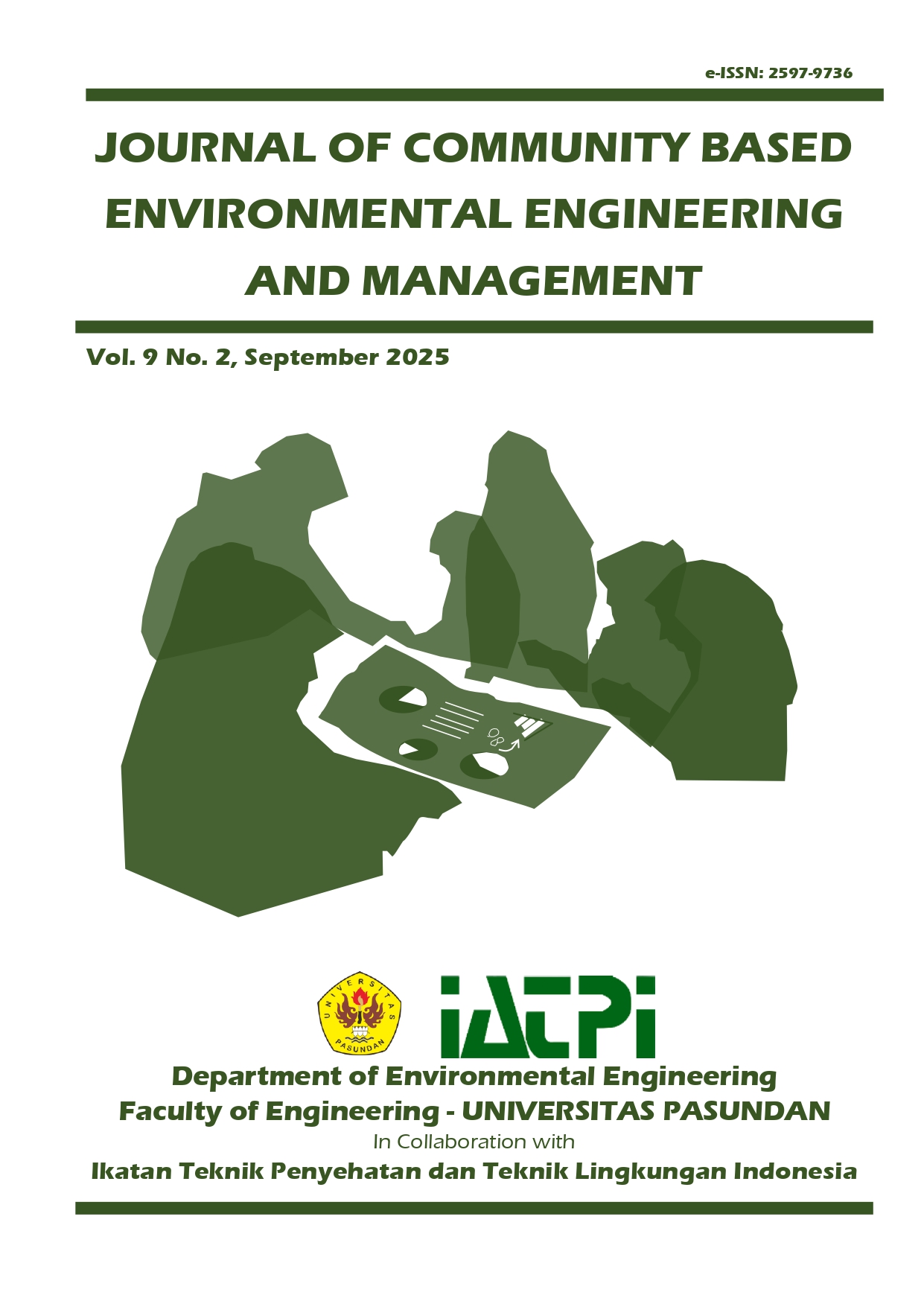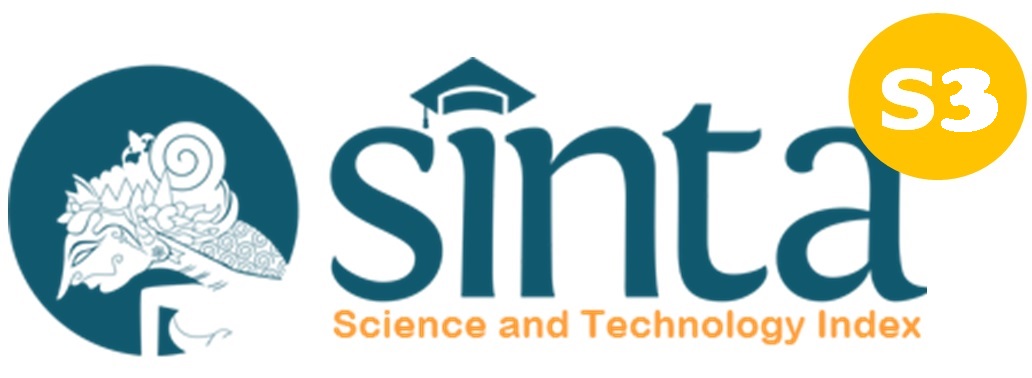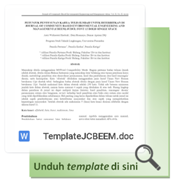Effectiveness of the Combination of Moving Bed Biofilm Reactor, Adsorption and Fenton Oxidation to Reduce Batik Waste Water Pollution
DOI:
https://doi.org/10.23969/jcbeem.v9i2.31216Keywords:
moving bed biofilm reactor, adsorption, geopolymer, batik waste, Fenton oxidationAbstract
Batik wastewater has a high organic and color content, requiring special treatment to meet environmental quality standards. This wastewater has an initial BOD5 of 605.405 mg/L, COD 714 mg/L, TSS 360 mg/L, and Pt-Co color of 992.2, far exceeding the quality standards. This study aimed to determine the effectiveness of a Moving Bed Biofilm Reactor (MBBR) combination with rice husk geopolymer-based adsorption and Fenton oxidation post-treatment in removing pollutants from Sidoarjo batik wastewater. Variations in HRT, adsorbent mass, MBBR media type, and chemical ratio were the independent variables in this study. The results showed that the MBBR-adsorption treatment unit performed better than the MBBR without adsorption. The MBBR-adsorption unit with wood charcoal media, HRT 48 hours, and adsorbent mass 20 grams were the most optimal conditions for reducing COD and BOD5, with removal values of 93.6% and 95.8%, respectively. Meanwhile, the most optimal color and TSS removal was achieved with a 48-hour HRT MBBR adsorption, Kaldness K3 media, and 20 grams of adsorbent mass, with values of 90.3% and 94.4%, respectively. The addition of the Fenton process after the MBBR adsorption process increased the efficiency of TSS and color removal, with a FeSO₂:H₂O₂ ratio of 1:3, resulting in a 50% increase in TSS and 52.2% increase in color removal.
Downloads
References
Akankshya, Dash, R. R., & Mohanty, S. (2021). Removal of organic matters and nutrients by using bio-balls and corn cobs as bio-film carrier in MBBR technology. In Water Security and Sustainability: Proceedings of Down To Earth 2019, 227-237. Singapore: Springer Singapore.
Aldris, B., & Farhoud, N. (2020). Wastewater treatment efficiency of an experimental MBBR system under different influent concentrations. Dynosa Applied Science, 1(1), 20-28.
Anisa, Ana, & Welly Herumurti. (2017). Pengolahan Limbah Domestik Menggunakan Moving Bed Biofilm Reactor (MBBR) dengan Proses Aerobik-Anoksik untuk Menurunkan Konsentrasi Senyawa Organik dan Nitrogen., Jurnal Teknik ITS, 6 (2), 361-366.
Anisah, N., & Hendrasarie, N. (2022). Penerapan Waktu Siklus Singkat pada Granular Activated Carbon Sequencing Batch Reactor untuk Pengolahan Limbah Cair Rumah Makan. Serambi Engineering, 7 (4). 3803-3811.
Arabgol, R. (2021). MBBR Produced Solids: Particle Characteristics, Settling Behaviour and Investigation of Influencing Factors. Doctoral Dissertation. Université d'Ottawa/ University of Ottawa).
Budirman, B. (2024). Effectiveness Of Using Biofilter Technology Moving Bed Biofilm Reaktor (MBBR) Combination Of Activated Carbon And Chlorine In Puskemas Wastewater Treatment In Makassar City. Doctoral Dissertation. Universitas Hasanuddin.
Fitriani, E., & Purbasari, A. (2021). Application of low-cost mesoporous geopolymer for dye waste removal. In IOP Conference Series: Materials Science and Engineering, 1053 (1), 012002.
Hakika, D.C., Sarto, S., Mindaryani, A., & Hidayat, M. (2019). Decreasing COD in sugarcane vinasse using the fenton reaction: The effect of processing parameters., Catalysts, 9(11), 881-892.
Hendrasarie, N., & Trilta, M. N. (2019). Removal of nitrogen-phosphorus in food wastewater treatment by the Anaerobic Baffled Reactor (ABR) and Rotating Biological Contactor (RBC). In IOP Conference Series: Earth and Environmental Science, 245(1), 012017.
Hendrasarie, Novirina, & Firdinsyah, Iqdam Zarfandi. (2023). Integrated Anoxic-Oxic Sequencing Batch Reactor Combined with Coconut Fiber Waste as Biofilm and Adsorbent Media. Journal of Ecological Engineering, 24 (11), 176-189.
Khudhair, D. N., Zwain, H. M., Siadatmousavi, S. M., & Hosseinzadeh, M. (2025). Sensitivity analysis of operational parameters on excess sludge reduction in moving bed biofilm reactor (MBBR) system upgraded to integrated fixed film activated sludge (IFAS) process based on GPS‐X environment. Water Environment Research, 97 (6), 70084.
Krupińska, I. (2024). Application of Fenton’s Reaction for Removal of Organic Matter from Groundwater. Molecules, 29(21), 5150-5170.
Liu, X., Tang, P., Liu, Y., Xie, W., Chen, C., Li, T., & Liu, B. (2022). Efficient removal of organic compounds from shale gas wastewater by coupled ozonation and moving-bed-biofilm submerged membrane bioreactor. Bioresource Technology, 344, 126191.
Martinez, D. V., Schambach, J. Y., Davydovich, O., Mascarenas, M. R., Butler, S. C., Kolker, S., ... & Kent, M. S. (2025). Chelator-mediated Fenton post-treatment enhances methane yield from lignocellulosic residues via microbial community modulation. Biotechnology for Biofuels and Bioproducts, 18 (1), 73-89.
Metcalf, L. & Eddy, HP. (2003). Wastewater engineering treatment and reuse. McGraw-Hill. 227-237. 2nd Ed. Singapore: Springer Singapore.
Mohanty, S., & Paul, S. (2021). Biofilm formation, problems, and diseases: Methods for film eradication, a nanostructured material based approach. Microbial Ecology of Wastewater Treatment Plants (pp. 469-492). 2nd Ed. Elsevier.
Prakoso, R. D., Hayati, R. N., & Rahendaputri, C. S. (2023). Pemanfaatan Kayu Gaharu (Aquilaria malaccensis) Sebagai Adsorben Dalam Menurunkan Parameter Warna dan pH di dalam Limbah Cair Tekstil Sintetis., Envirotek, 15 (2), 181-185.
Pratama, A., & Hendrasarie, N. (2021). Efektivitas Penambahan Green Adsorbent Di Sequencing Batch Reactor Untuk Menurunkan Parameter Bod, Tss, Dan Warna Pada Limbah Industri Batik., EnviroUS, 2 (1), 9-17.
Pratap, V., Kumar, R., Kumar, S., & Yadav, B. R. (2024). Optimization of moving bed biofilm reactors for the treatment of municipal wastewater. Environmental Research, 241, 117560.
Sekarani, F.A., & Hendrasarie, N. (2020). Reduction of organic parameters in apartment wastewater using sequencing batch reactor by adding activated carbon powder. In IOP Conference Series: Earth and Environmental Science, 506 (1), 012026.
Shitu, A., Tadda, M. A., Li, H., Danhassan, U. A., Gouda, M., Zhou, J., & Zhu, S. (2025). Performance and microbial community structure of BC/FeC2O4/SB modified carriers on the nitrogen removal from mariculture wastewater. International Journal of Environmental Science and Technology, 22(13), 1-16.
Suryawan, I. W. K., Helmy, Q., Notodarmojo, S., Pratiwi, R., & Septiariva, I. Y. (2021). Textile dye reactive black 5 (rb5) bio-sorption with moving bed biofilm reactor and activated sludge. Indonesian Journal of Environmental Management and Sustainability, 5 (2), 67-71.
Wahyu, E., & Hendrasarie, N. (2022). Penurunan kandungan zat pencemar organik pada air limbah rumah potong ayam dengan biofilter aerob menggunakan media kulit kerang. Jurnal Envirous Teknik Lingkungan, 3(1), 19-25.
Wang, Z. Y., Ju, C. J., Zhang, R., Hua, J. Q., Chen, R. P., Liu, G. X., ... & Yu, L. (2021). Acceleration of the bio-reduction of methyl orange by a magnetic and extracellular polymeric substance nanocomposite. Journal of Hazardous Materials, 420, 126576.
Zhang, D., Zhang, K., Hu, X., He, Q., Yan, J., & Xue, Y. (2021). Cadmium removal by MgCl2 modified biochar derived from crayfish shell waste: Batch adsorption, response surface analysis and fixed bed filtration. Journal of Hazardous Materials, 408, 124860.
Zheng, Y., Zimmerman, A. R., & Gao, B. (2020). Comparative investigation of characteristics and phosphate removal by engineered biochars with different loadings of magnesium, aluminum, or iron. Science of the Total Environment, 747, 141277














